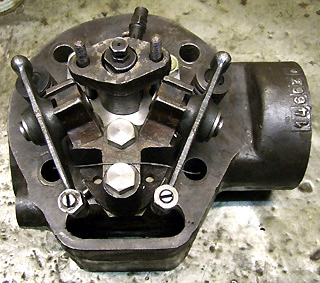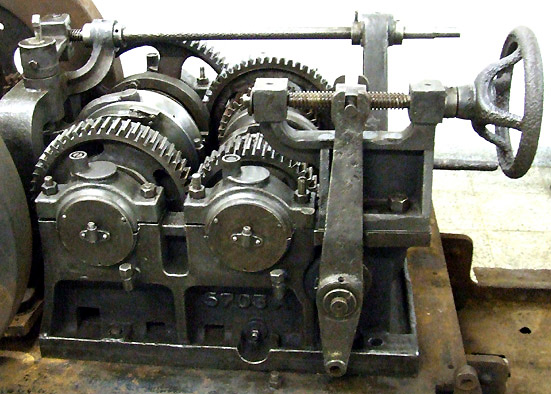December 2006
 In
the never ending story of the reconstruction of the RL3 No.
20787 a new and hopefully the last chapter is opened: the
locomotive stands without its front axle on sleeper piles in the
workshop. In order to eliminate the pressure between the rods
and the wheels, in last autumn the axle boxes were adjusted by
plates. After this it was only possible to mount the rod on one
side, the crankpins of the wheels and the jackshaft on the other
side were not in one line. The fact was that the wheels of the
front axle were not in an exact 90° position. Today we can
only assume the reason of this deviation, may be the loco had
a small accident by a stone, rolling under the rod of the running
machine. May be this circumstance saved the loco until today:
all of her usable sisters have been sold and later scrapped in
the seventies. Only the 20787 remained in the abandoned brick
yard. Now it's necessary to dismount one wheel and to remount
it in the right position. It will not be an easy task but it will
be solvable.
In
the never ending story of the reconstruction of the RL3 No.
20787 a new and hopefully the last chapter is opened: the
locomotive stands without its front axle on sleeper piles in the
workshop. In order to eliminate the pressure between the rods
and the wheels, in last autumn the axle boxes were adjusted by
plates. After this it was only possible to mount the rod on one
side, the crankpins of the wheels and the jackshaft on the other
side were not in one line. The fact was that the wheels of the
front axle were not in an exact 90° position. Today we can
only assume the reason of this deviation, may be the loco had
a small accident by a stone, rolling under the rod of the running
machine. May be this circumstance saved the loco until today:
all of her usable sisters have been sold and later scrapped in
the seventies. Only the 20787 remained in the abandoned brick
yard. Now it's necessary to dismount one wheel and to remount
it in the right position. It will not be an easy task but it will
be solvable.
 Unfortunately
the coiled springs by O&K tend to brake frequently with increasing
age. So far I used spiral springs as substitute, which were built
for heavy mining cars. Because the springs of the locomotives
are free visible, there was the goal to rebuilt new "old"
springs already for a long time. In order to receive a favourable
price, four orderers joined. So could be manufactured an accordingly
large number of springs (30). The Bischoff
company in Stassfurt delivered an excellent work!
Unfortunately
the coiled springs by O&K tend to brake frequently with increasing
age. So far I used spiral springs as substitute, which were built
for heavy mining cars. Because the springs of the locomotives
are free visible, there was the goal to rebuilt new "old"
springs already for a long time. In order to receive a favourable
price, four orderers joined. So could be manufactured an accordingly
large number of springs (30). The Bischoff
company in Stassfurt delivered an excellent work!
November 2006
The motor that's present mounted on the
MD1 was originally as an exchange engine on the type M
loco. Together with their it had been on the ground of a shut
down quarry for approx. 30 years . Before this "scrapping"
somebody had dismantled still the cylinder head and the water
pump. These circumstances were very bad for the motor and thus
it wasn't planned to restore it. That did also not change when
the MD1 with an exchange engine came into the collection, because
the missing cylinder head was not replaceable. But persistent
asking around led to the fact that a cylinder head could be bought
after some years. However, the existing attachments (rocker lever
block and nozzle holder) of MD2 and RL1c did not fit to the head,
which comes probably still from a type MD motor. After longer
puzzle about it, how the problem was to be solved by a specialty
firm here in Dresden. They manufactured an adapter that the accessories
makes suitable to the cylinder head.
 _
_ _
_
October 2006
Because the restoration of the benzene
locomotive is very complex and some difficulties are predictable
, it doesn't exist a schedule for this task. The work takes place
in small steps and rather besides. As the first stage this way
the gear box was divided and re-mounted. Only a disk, which broke
when forcing and the bearing bushes in two gear wheels had to
be renewed, all other parts can be used furthermore. For the refurbishing
of the locomotive framework the gear box is removable as a whole
of the locomotive later.
 _
_
May 2006
There is new acquisition in the collection:
a SCHÖMA Lo20. It looks with their porthole windows
a little as from an animated cartoon. The propulsion principle
with pendular axle and Cardan drive is remarkable. If the gauge
of the locomotive will be changed from 890mm to 600mm, it is to
be used in Glossen, because it is similar to the DIEMA locos working
there in former times.
 _
_
February 2006
The French RL1a was functional
again after the repair of the engine, but it inclined to derail
and could not be pushed by hand not. The reason for it was that
the bearing surfaces of the wheels had strongly run in. Thus resulted
different wheel diameters, which had the consequence to force
strong the chain between both axes. When the axes were dismounted,
it turned out that the wheel circumferences were far away from
the ideal circle. Due to the extreme hardness of the bearing surfaces
(the material was cold-rolled over decades in use) it was necessary
to work with the friction disk, before the axes could on the centre
lathe. The diagonal grooves were removed again with a particularly
hard roughing disk. Partially up to 15mm material from the radius
were taken away. Fortunately the technical designers had planned
enough reserves.
 _
_
 In
the never ending story of the reconstruction of the RL3 No.
20787 a new and hopefully the last chapter is opened: the
locomotive stands without its front axle on sleeper piles in the
workshop. In order to eliminate the pressure between the rods
and the wheels, in last autumn the axle boxes were adjusted by
plates. After this it was only possible to mount the rod on one
side, the crankpins of the wheels and the jackshaft on the other
side were not in one line. The fact was that the wheels of the
front axle were not in an exact 90° position. Today we can
only assume the reason of this deviation, may be the loco had
a small accident by a stone, rolling under the rod of the running
machine. May be this circumstance saved the loco until today:
all of her usable sisters have been sold and later scrapped in
the seventies. Only the 20787 remained in the abandoned brick
yard. Now it's necessary to dismount one wheel and to remount
it in the right position. It will not be an easy task but it will
be solvable.
In
the never ending story of the reconstruction of the RL3 No.
20787 a new and hopefully the last chapter is opened: the
locomotive stands without its front axle on sleeper piles in the
workshop. In order to eliminate the pressure between the rods
and the wheels, in last autumn the axle boxes were adjusted by
plates. After this it was only possible to mount the rod on one
side, the crankpins of the wheels and the jackshaft on the other
side were not in one line. The fact was that the wheels of the
front axle were not in an exact 90° position. Today we can
only assume the reason of this deviation, may be the loco had
a small accident by a stone, rolling under the rod of the running
machine. May be this circumstance saved the loco until today:
all of her usable sisters have been sold and later scrapped in
the seventies. Only the 20787 remained in the abandoned brick
yard. Now it's necessary to dismount one wheel and to remount
it in the right position. It will not be an easy task but it will
be solvable. Unfortunately
the coiled springs by O&K tend to brake frequently with increasing
age. So far I used spiral springs as substitute, which were built
for heavy mining cars. Because the springs of the locomotives
are free visible, there was the goal to rebuilt new "old"
springs already for a long time. In order to receive a favourable
price, four orderers joined. So could be manufactured an accordingly
large number of springs (30). The
Unfortunately
the coiled springs by O&K tend to brake frequently with increasing
age. So far I used spiral springs as substitute, which were built
for heavy mining cars. Because the springs of the locomotives
are free visible, there was the goal to rebuilt new "old"
springs already for a long time. In order to receive a favourable
price, four orderers joined. So could be manufactured an accordingly
large number of springs (30). The  _
_ _
_
 _
_
 _
_
 _
_